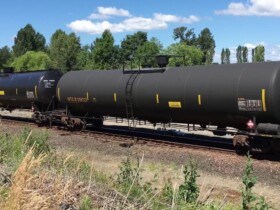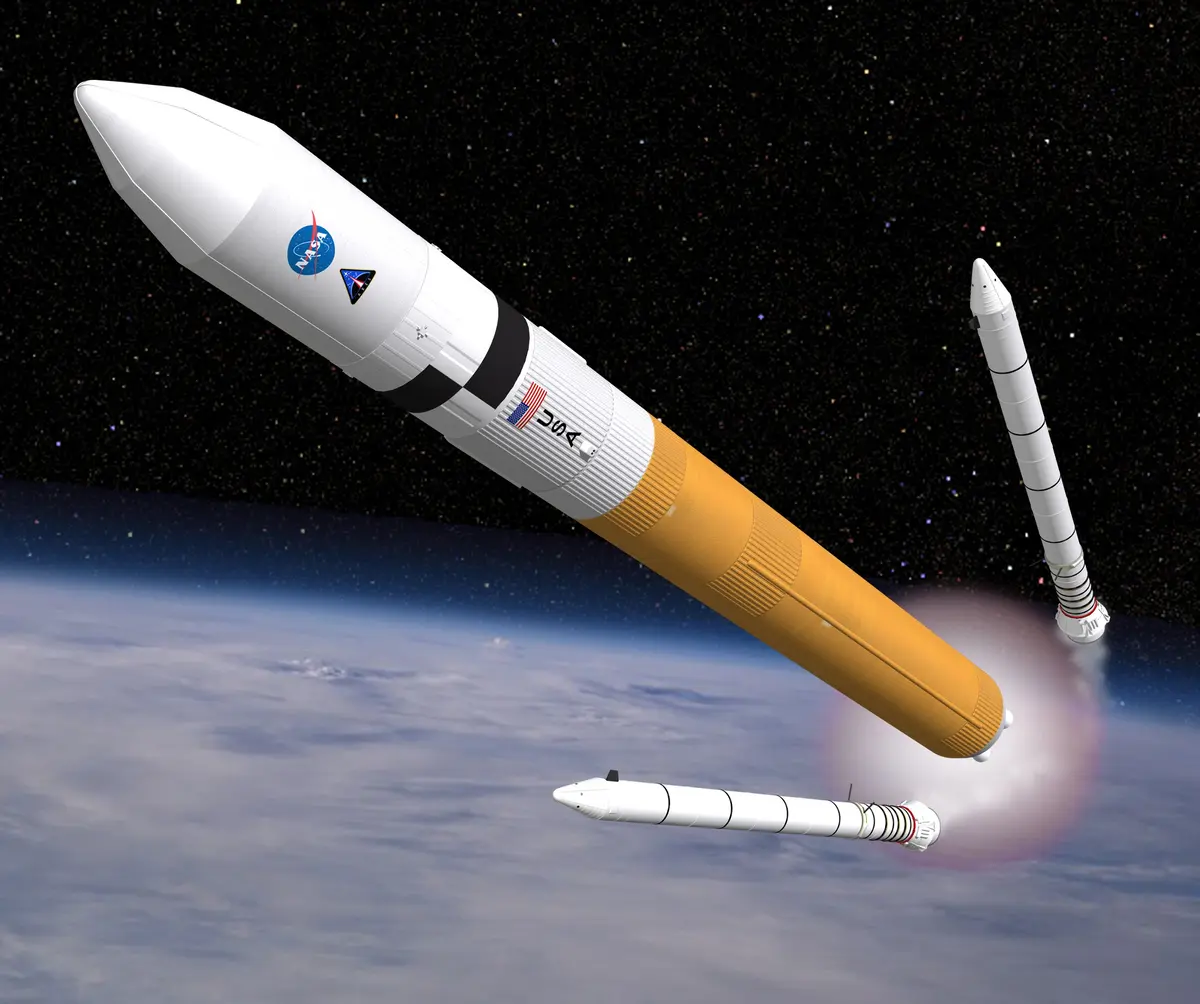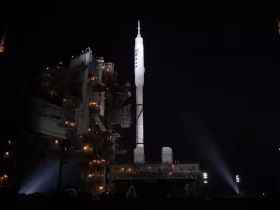
Ares V, NASA’s proposed heavy-lift lunar exploration cargo launch vehicle, cancelled with Project Constellation on February 1, 2010, came close to finally realizing the long-considered “Shuttle-derived” concept. The Shuttle-derived idea had been around for decades. Studies of heavy-lift Shuttle-derived launch vehicles actually predated Space Shuttle.
Ares V promised to be an unprecedented earth-shaking colossus. Design changes gradually made it taller, heavier, more powerful, and more capable than Saturn V, or any other launch vehicle in history.
Ares V was designed to orbit the 51 tonne “Altair” lunar lander along with the Earth Departure Stage (EDS). A smaller Ares I would subsequently launch an Orion spacecraft crewed by four astronauts. Orion would rendezvous and dock with the EDS/Altair stack, forming a structure that at 201 tonnes would weigh more than some fully-fueled launch vehicles at liftoff. The EDS, which would have expended about 150 tonnes of propellant during its ascent to LEO, would then burn its remaining 100 tonnes or so of propellant to send Orion and Altair toward the Moon.
One Later Design – Six RS-68s and Two 5.5 SRBs
On June 23, 2008, NASA’s Constellation Program Manager Jeff Hanley announced that the Ares V baseline design had grown larger and more powerful than previous designs. The trans-lunar insertion (TLI) capability had risen to 71 tonnes, a 7 tonne increase. The theoretical Low Earth Orbit (LEO) payload had grown to 145 tonnes or more from the previous 130-ish tonnes (see Table 1 for Details).
Planners added a sixth RS-68 engine to the core stage and specified a pair of five-and-a-half segment solid rocket boosters. The previous design used five RS-68s and two five-segment boosters. The core stage was lengthened. The Earth Departure Stage (EDS) diameter had already been increased to 10 meters to match the core diameter during recent design iterations. The payload fairing diameter also grew to 10 meters. Overall height jumped to 116.16 meters, 5.56 meters taller than Saturn V. Liftoff weight increased to 3,699.23 tonnes and liftoff thrust to an unprecedented 5,306 tonnes.
The bigger Ares V would require the rebuilding of the existing Launch Complex 39 crawlerway. All-new crawler transporters and mobile launch platforms would also be needed. A new launch pad might even be necessary.
The Ares V designed continued to evolve through “Phase A” design definition work in 2009. A Systems Requirements Review (SRR) for Ares V and Altair was expected in 2010, but never occurred. Actual work on the big rocket would not have begun until after Shuttle’s retirement in 2010. First launch would not have occurred until 2018 at the earliest. The EDS and core stages would have been manufactured at the Michoud Assembly Facility near New Orleans.
Read also: Ares I-X Flight Test – Space Launch Report
The Road to Ares V – a Partial History

Boeing performed the first “Shuttle-derived” launch vehicle study for NASA in 1977, four years before the first Space Shuttle flight. The idea was repeatedly examined during the following decades.
The Shuttle-derived idea faded in the face of budget realities during the later 1990s, but reappeared after the 2003 loss of orbiter Columbia and crew. The early 2004 “Vision for Space Exploration” plan announced by President Bush, a long-term plan for NASA to retire Shuttle and to send astronauts to the Moon and eventually Mars, prompted several reassessments. Heavy-lift proposals were quickly dusted off, especially when it became apparent that NASA was interested in a capsule based approach.
Marshall Space Flight Center’s External Tank Project Office, along with Lockheed Martin, Boeing, and Orbital Sciences, proposed an 80 tonne to LEO “Magnum” type design boosted by four expendable SSMEs. The ET-derived core stage could fly alone, topped by an upper stage, to launch a 20 tonne Crew Exploration Vehicle. The core alone, boosted by four or five segment SRBs, would be added to lift up to 70 or 80 tonnes to LEO. When a J-2S power upper stage was added, the vehicle would be able to orbit 109 tonnes.
ATK also proposed use of four or five expendable SSMEs on an ET-based core augmented by new five-segment SRBs. An upper stage could be powered by an SSME or by a pair of J-2S engines. LEO payloads of 100 tonnes to more than 135 tonnes were suggested.
ATK also famously proposed a separate “single-stick” Crew Launch Vehicle that would use a single SRB topped by a new upper stage. This approach was soon embraced by incoming NASA Administrator Michael Griffin. Soon after taking office In 2005, Griffin assigned a committee to perform the landmark Exploration Systems Architecture Studies (ESAS), which examined a wide variety of launch systems for exploring the Moon and Mars. The final ESAS recommendation looked much like ATK’s 2004 proposal, which in turn was heavily based on “Magnum”, “Comet”, “Mars Direct Ares”, National Launch System and others.
Ares V Defined, and Redefined
The preferred ESAS heavy-lift “Cargo Launch Vehicle” (CaLV), identified as “LV 27.3”, used five-segment SRBs with HTPB propellant rather than the Shuttle SRB PBAN propellant. The ET-based core was powered by five SSMEs. The “Earth Departure Stage” (EDS, or second stage) was powered by a pair of J-2S engines. “LV 27.3” was expected to be able to deliver 126 tonnes to a 56 x 111 km x 28 deg insertion orbit, or 54.6 tonnes directly to trans lunar injection (TLI). The upper stage would be able to boost 68.6 tonnes to TLI if a rendevous mission with an Ares I launched CEV were performed.
In 2006, NASA substantially modified the CaLV design, expanding the core stage to 10 meters in diameter, replacing the core stage SSMEs with five RS-68 engines, and replacing the specified pair of J-2S second stage engines with a single new higher-performance “J-2X” engine. Only the second stage retained the Shuttle External Tank diameter. The new rocket, able to boost nearly 130 tonnes to a 222 km LEO, was named “Ares V” in late 2006. This Ares V essentially served as the baseline until mid to late 2007.
During 2007, increasing performance requirements forced NASA to consider more powerful Ares V designs. A large trade study, involving dozens of designs that were given “LV 45”, “LV 46”, and “LV 47” series designations examined methods to improve performance. Concepts included additional solid boosters or liquid boosters, use of new-design composite case SRBs, use of additional series core stages, use of a fatter core, and the addition of a sixth RS-68 core stage engine. Selected changes were gradually adopted into a new “LV 51” series baseline during the last months of 2007.
Read also: Space Launch Report – Ares I
An early change increased the diameter of the upper stage and payload shroud to 10 meters, matching the core diameter. Additional changes included increased SRB nozzle length, changes to the solid propellant mix, improved SRB vacuum specific impulse, bettered RS-68 thrust and specific impulse, and increased use of lighter weight composite structures. In early 2008, 5.5 segment SRBs and a sixth RS-68 were added. In 2009, NASA began reconsidering use of RS-68, again contemplating use of an SSME cluster, and even the ET-diameter tank, in an “Ares V Lite” design mentioned in the Augustine Committee final report.
At the end, it could be argued that Ares V was barely, if at all, “Shuttle-derived” since it no longer used Space Shuttle four-segment SRBs, External Tanks, or Space Shuttle Main Engines. Ares V would, however, have been built, tested, and launched using modified Space Shuttle facilities. In broad architecture, if not in detail, Ares V harkened back to numerous Shuttle-derived in-line designs studied for more than 30 years.
| Ares V Details (Subject to Change) |
| Oct 2005 LV 27.3 | Mid 2006 | Mid 2007 | April 2008 LV 51.0.39 | June 2008 LV 51.00.48 | |
| Boosters (Each) | 5 Segment | 5 Segment | 5 Segment | 5 Segment | 5.5 Segment |
| GLOW (tonnes) | 751.084 t | 735.81 t | 731.74 t | 730.95 t | 791.354 t |
| Propellant Mass (tonnes) | 650.751 t | 629.51 t | 626.25 t | 630.63 t | 684.998 t |
| Burnout Mass (tonnes) | 100.333 t | 106.31 t | 105.49 t | 100.31 t | 106.356 t |
| Diameter (meters) | 3.71 m | 3.71 m | 3.71 m | 3.71 m | 3.71 m |
| Height (meters) (to top of frustum) | 53.87 | 53.87 m | 53.87 m | 54.63 m | 58.69 m |
| Liftoff Thrust (vac. tonnes) | 1,578.29 t | 1,580.12 t | 1,592.20 t | 1,619.94 t | 1,697.959 t |
| Specific Impulse (sea level/vacuum, seconds) | 242 s/265.4 s | 237s/265.5 s | 237s/267.4 s | — s/272.8 s | 237 s/275.7 s |
| Burn Time (sec) | 126.6 s | 126.6 s | 125.9 s | 116.4 s | |
| Propellant | HTPB | PBAN | PBAN | PBAN | PBAN |
| Core Stage | 5xSSME | 5xRS68 | 5xRS68B | 5xRS68B | 6xRS68B |
| GLOW (tonnes) | 1,102.33 t | 1,559.42 t | 1,548.342 t | 1,585.58 t | 1,760.74 t |
| Usable Propellant Mass (tonnes) | 1,004.71 t | 1,401.83 t | 1,396.104 t | 1,435.28 t | 1,587.06 t |
| Burnout Mass (tonnes) | 97.62 t | 157.59 t | 152.238 t | 150.30 t | 173.68 t |
| Dry Mass (tonnes) | 88.43 t | 141.87 t | 136.908 t | 134.67 t | 157.36 t |
| Diameter (meters) | 8.384 m | 10 m | 10 m | 10 m | 10 m |
| Height (meters) | 64.27 m | 64.81 m | 65.03 m | 67.73 m | 71.28 m |
| Thrust (sea level/vacuum, tonnes) | 850.75 t/1,064.50 t | 1,495 t/1,705 t | 1,561.66 t/1,777.78 t | 1,591.96 t/1,807.26 t | 1,910.35 t/2,168.71 t |
| Specific Impulse (sea level/vacuum., seconds) | 361.3 s/452.1 s | 357 s/409 s | 360.8 s/414.2 s | 360.8 s/414.2 s | 364.9 s/414.2 s |
| Burn Time (sec) | 325.3 s | 328.9 s | 303.1 s | ||
| Propellants | LOX/LH2 | LOX/LH2 | LOX/LH2 | LOX/LH2 | LOX/LH2 |
| Interstage (Core/EDS) | |||||
| Dry Mass (tonnes) | 8.09 t | 8.09 t | 8.09 t | 8.47 t | 9.19 t |
| Second (Earth Departure) Stage | 2xJ2S | 1xJ2X | 1xJ2X | 1xJ2X | 1xJ2X |
| GLOW (tonnes) | 228.716 t | 245.81 t | 245.57 t | 259.52 t | 279.40 t |
| Usable Propellant Mass (tonnes) | 206.657 t | 226.26 t | 223.47 t | 234.45 t | 253.01 t |
| First Burn Propellant (tonnes) | 131.52 t | 140.59 t | 149.66 t | ||
| Burnout Mass (tonnes) | 22.059 t | 19.55 t | 22.10 t | 25.07 t | 26.39 t |
| Dry Mass (tonnes) | 19.340 t | 16.43 t | 21.54 t | 22.74 t | 24.00 t |
| Diameter (meters) | 8.384 m | 8.38 m | 8.38 m | 10 m | 10 m |
| Height (meters) (including interstage) | 22.74 m | 22.20 t | 23.29 m | 22.5 m | 21.68 m |
| Thrust (vac., tonnes) | 248.98 t | 133.22 t | 133.33 t | 133.33 t/107.94 t | 133.33 t/107.94 t |
| Specific Impulse (vac., seconds) | 451.5 s | 450 s | 448 s | 448 s/449 s | 448 s/449 s |
| Burn Times (first burn/TLI burn, sec) | 751.7 s | 472.4 s/390.4 s | 502.9 s/429.9 s | ||
| Propellants | LOX/LH2 | LOX/LH2 | LOX/LH2 | LOX/LH2 | LOX/LH2 |
| Payload Fairing | 22 x 8.38 m | 22 x 8.38 m | 22 x 8.38 m | 21.68 x 10 m | 21.68 x 10 m |
| Dry Mass (tonnes) | 5.836 t | 5.836 t | 5.836 t | 8.793 t | 9.049 t |
| Ares V Total | |||||
| GLOW (tonnes) | 2,899.76 t | 3,332.37 t | 3,322.62 t | 3,374.30 t | 3,699.23 t |
| Height (meters)(including payload) | 109.02 m | 109.02 m | 110.32 m | 109.91 m | 116.18 m |
| Height (meters) (not including payload) | 87.00 m | 87.01 m | 88.32 m | 88.23 m | 94.51 m |
| Payload (tonnes) to 220 km x 28.5 deg | ~120 t | ~130 t | 128.76 t | ~127 t | ~145 t |
| Payload (tonnes) to TLI (including CEV launched by Ares I) | 60.60 t | 65.40 t | 64.65 t | 63.57 t | 71.10 t |
References:
- The Role, Rationale, and Economics of a Shuttle Derived Cargo Vehicle, Frank Williams and Robert Tewell, Martin Marietta Aerospace, 1983..
- Advanced Transportation Systems Studies, Technical Area 2, Heavy Lift Launch Vehicle Development Contract, NAS8-39208, Final Report, Lockheed Martin Missiles and Space for the Launch Systems Concepts Office of the George C. Marshall Space Flight Center, July 1995.
- Heavy Lift Launch for Lunar Exploration, Michael D. Griffin, University of Wisconsin Lecture, 1997.
- Extending Human Presence into the Solar System, An Independent Study for the Planetary Society on Strategy for the Proposed U.S. Space Exploration Policy, July 2004.
- Service Life Extension Program Summit 2, Strategy Panel, Presentation by Doug Cooke, Chair, February 17, 2004.
- Exploration Transportation System, Presentation by Mike Kahn of ATK at the 2004 Space Congress, April 2004.
- Shuttle Derived Launch Vehicles – A Solution for Space Access, James A. Furfaro and Dennis G. Johnson, ATK Thiokol Inc., 2005.
- Shuttle Derived In-Line Heavy Lift Vehicle, Terry Greenwood, MSFC, 2005.
- NASA’s Exploration Systems Architecture Study (ESAS), Final Report, NASA-TM-2005-214062, November 2005.
- Upper Stage Request for Information, NASA’s Exploration Launch Office, March 20, 2006.
- Ares Project Status, Presentation by Steve Cook, Director Exploration Launch, NASA, Second AIAA Space Exploration Conference, December 2006.
Author
by: Ed Kyle
Updated: 2/1/2010
















Got a Questions?
Find us on Socials or Contact us and we’ll get back to you as soon as possible.